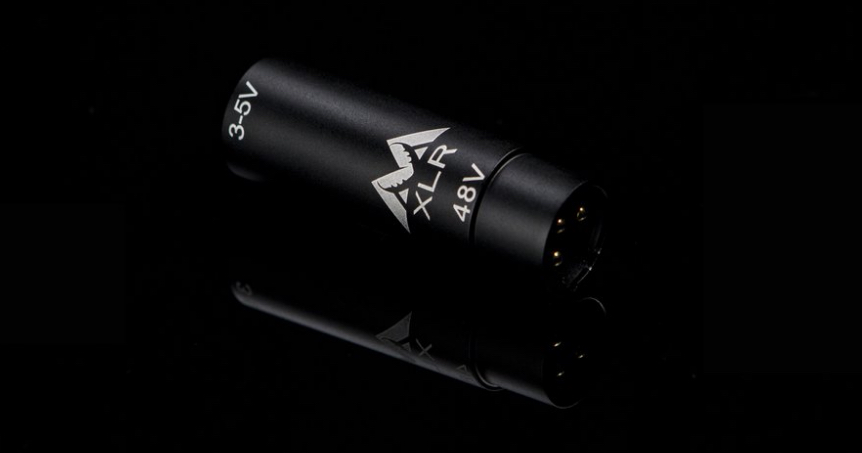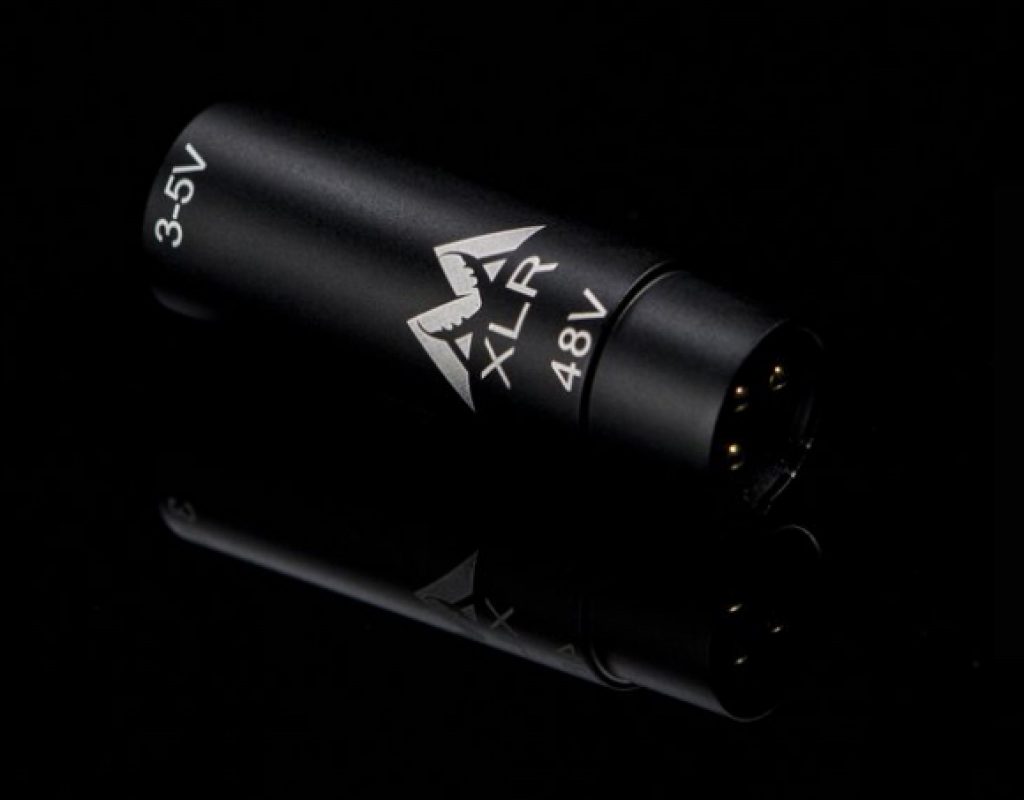
Antlion Audio recently introduced its new US$24.95 XLR Power Converter which now directly competes with RØDE’s US$25 VXLR+ which I reviewed in 2017. The two devices have more similarities than differences: They both convert high voltage phantom power used with pro balanced mic inputs into the much lower bias voltage (plugin power) required by many unbalanced electret condenser mics, including Antlion Audio’s detachable ModMic5 head microphone I reviewed in 2017, as well as many low-cost, unbalanced lavalier mics and camera mics. Both devices could both be called “a bridge over troubled waters” (thanks Simon & Garfunkel). Ahead we’ll explore the new model and compare both performance and feature differences. I’ll also help you choose among them.
Unique feature in Antlion converter not in RØDE’s VXLR+
The XLR Power Converter from Antlion (Amazon) has a custom tuned low-end response to compensate for the proximity effect of head-mounted boom microphones like the ModMic 5 (reviewed here, Amazon) and lavalier microphones mounted in a head mount like the RØDE Lav-Headset. These mics are placed very close to the vocal source when mounted on headphones, resulting in a corresponding increase in low-frequency response. According to Antlion:
“The XLR Power Converter compensates for this boost, creating a natural response that is pleasing to the ear, as well as extending headroom and allowing for a lower noise floor in practical applications.”
Above: Actual size photo of both compared units units.
Even though Antlion doesn’t promote it specifically, its Power Converter also offers a much higher output level than the RØDE VXLR+ (which I reviewed in 2017, Amazon — B&H), as explained in more detail ahead. This can mean a higher general signal to noise ratio, by making the connected preamp work much less. In the upcoming section, you’ll get to hear how the ModMic 5 sounds when connected three different ways.
Unique features in the RØDE VXLR+ not currently included in Antlion’s converter
- The RØDE VXLR+ includes a belt clip, which provides strain relief to the microphone. (In the future, Antlion might offer such a belt clip for its XLR Power Converter, but this is pure speculation on my part.)
- The RØDE VXLR+ has a threaded 3.5 mm input jack, although it is completely compatible with 3.5 mm plugs which are not threaded. When used with a head microphone like the RØDE HS2 (which I also reviewed in 2017), more strain relief exists for the microphone.
- While Antlion vehemently states that its XLR Power Converter does not have a balanced XLR output, in conversations with RØDE last year, the company explained that the VXLR+ has a semi-impedance balanced XLR output. However, this is of no consequence when the XLR end of either of these two devices is plugged directly to its final destination, i.e. directly to the XLR input of a recorder, audio mixer or camcorder which supplies phantom power. Its only potential consequence could be when the device is connected to a long XLR cable and finally to the destination with an XLR input. See my article Balanced audio: benefits and varieties from 2017.
Test recordings
All of the below recordings were made using different connections of the Zoom H5 recorder (Amazon — B&H). Although the first one was forced to be dual mono, i.e. a stereo file with identical content in each channel, I later monified it. The other two were born mono. All original recordings were made at the absolute video standard of 48 kHz (see All audio production & distribution should go 48 kHz. Learn why.) and 24-bit resolution (see Understanding 24-bit vs 16-bit audio production & distribution). I normalized and trimmed the WAV files in Fission 2.4.1 for Mac, from Rogue Amoeba. I applied no filtering or equalization or compression.
Above, the ModMic 5 microphone was plugged directly into Zoom H5’s own 3.5 mm TRS input on its included XYH-5 mic module. In order to make the raw recording at -12 dB, I set the XYH-5 potentiometer to 6. I later monified (converted it into mono) and normalized it.
Above, the ModMic 5 microphone was plugged into the RØDE VXLR+. In order to make the raw recording a -12 dB, I set potentiometer 1 of the Zoom H5 to 5. I later normalized it.
Above, the ModMic 5 microphone was plugged into the Antlion Audio XLR Power Converter with its own equalization to compensate for the proximity effect. The output level was unexpectedly high. In order to make a raw recording of -12 dB, I lowered potentiometer 1 of the Zoom to 3. I later normalized it.
Feel free to tell me in the comments below how each one sounds to you, and which sound you prefer.
Additional advantage of connecting a mono mic via one of these adapters to the H5 recorder
Due to the Zoom H5’s design (at least with the latest firmware), it is currently impossible to make a mono recording from a source plugged into the XYH-5 mic module’s TRS 3.5 mm. Even though the connected microphone is mono, the Zoom H5 forces us to create a stereo recording from anything plugged into the XYH-5, at twice the ideal size. This occupies twice the space and —if required to upload to a server or send to an editor— can take twice the transfer time and even use twice the bandwidth in the case of metered Internet service.
On the other hand, by making a mono recording of a mono source, we get better efficiency in space, transfer time and metered bandwidth. This is equally valuable, even if the mono recording is to be used —centered— in a stereo project.
Above: Actual size photo of the Zoom H5 with each compared device.
How to choose which device
The following criteria should help you decide:
- Does your intended unbalanced microphone have a threaded 3.5 mm plug? If so, consider the VXLR+ to take advantage of the strain relief, since this feature isn’t available in the current Antlion converter. If your intended mic is a ModMic (any model) or any other unbalanced electret condenser microphone without a threaded 3.5 mm plug, keep reading:
- Do you have an important need for a belt clip on your converter? If so, consider the VXLR+, until least as such time that Antlion ever offers a belt clip, if it ever does. However, this might be less important than the next condition, below.
- Does your intended microphone currently “suffer” or “benefit” from the proximity effect? In other words, does your microphone sound extra bassy when very close to the person speaking? If it “suffers” from the proximity effect (i.e. you don’t like the extra bass), then consider the Antlion Audio XLR Power Converter since it will reduce that extra bass. If —on the other hand— you believe that the extra bass improves the sound, than consider the VXLR+ since it will retain that effect.
Photo credits
The main image of this article is courtesy of Antlion Audio. I took all of the other photos with my Google Pixel XL phone and doctored them with Google Photos and Apple Keynote. Thanks to Francisco Javier Arbolí for modeling the belt clip.
(Re-)Subscribe for upcoming articles, reviews, radio shows, books and seminars/webinars
Stand by for upcoming articles, reviews, and books. Sign up to my free mailing list by clicking here. If you previously subscribed to my bulletins and no longer receive them, you must re-subscribe due to new compliance to GDPR. Most of my current books are at books.AllanTepper.com, and my personal website is AllanTepper.com.
Si deseas suscribirte (o volver a suscribirte) a mi lista en castellano, visita aquí. Si prefieres, puedes suscribirte a ambas listas (castellano e inglés).
Suscribe to his BeyondPodcasting show at BeyondPodasting.com.
Subscribe to his Tu radio global show at Turadioglobal.com.
Subscribe to his Tu salud secreta show at TuSaludSecreta.com.
Subscribe to his CapicúaFM show at CapicúaFM.com.
Save US$20 on Project Fi, Google’s mobile telephony and data
Click here to save US$20 on Project Fi, Google’s mobile telephone and data service which I have covered in these articles.
FTC disclosure
No manufacturer is specifically paying Allan Tépper or TecnoTur LLC to write this article or the mentioned books. Some of the other manufacturers listed above have contracted Tépper and/or TecnoTur LLC to carry out consulting and/or translations/localizations/transcreations. Many of the manufacturers listed above have sent Allan Tépper review units. So far, none of the manufacturers listed above is/are sponsors of the TecnoTur , BeyondPodcasting or TuNuevaRadioGlobal programs, although they are welcome to do so, and some are, may be (or may have been) sponsors of ProVideo Coalition magazine. Some links to third parties listed in this article and/or on this web page may indirectly benefit TecnoTur LLC via affiliate programs. Allan Tépper’s opinions are his own.
Copyright and use of this article
The articles contained in the TecnoTur channel in ProVideo Coalition magazine are copyright Allan Tépper/TecnoTur LLC, except where otherwise attributed. Unauthorized use is prohibited without prior approval, except for short quotes which link back to this page, which are encouraged!

